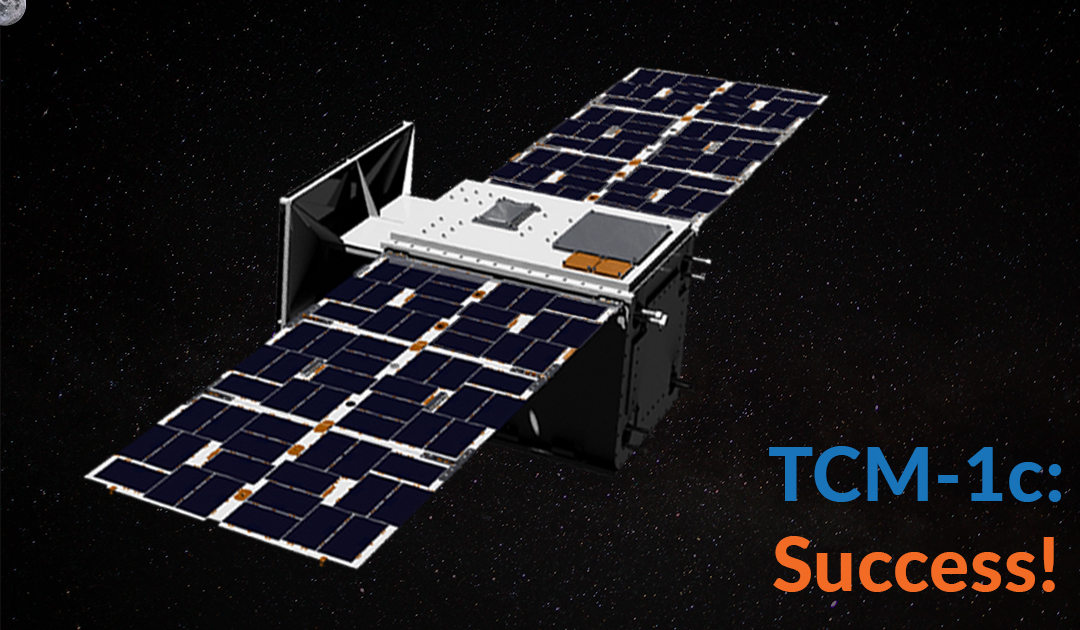CAPSTONE achieved another positive milestone today after the spacecraft executed the second scheduled trajectory correction maneuver (TCM) today at approximately 9:30 am MT. The spacecraft burn was relatively small as it consumed ~35 grams of fuel. The purpose of the maneuver completes the corrective actions of the spacecraft separation from the Lunar Photon – a necessary and routine step to ensure the transfer trajectory remains on track. Even though this was a small maneuver, this further validates the spacecraft design, which was optimized for precise orbital operations.
Below lists some additional details from today’s activity:
- The spacecraft executed the maneuver autonomously and afterward relayed the maneuver performance and its status down to ground control.
- A first look at the maneuver telemetry shows that the spacecraft propulsion system fired for the nominal duration of 53 seconds.
- At the time of maneuver execution, the spacecraft was approximately 789,000km from the Earth (~22 times further than the GEO belt and ~405,000 km further than the Moon) and moving approximately 587 m/s, or 1313 mph.
- This maneuver was much smaller than the first trajectory correction maneuver last Thursday. This is an intentional shift in the spacecraft commissioning, demonstrating a smaller, more graceful, and precise maneuver in preparation for the future NRHO stationkeeping operations.
- Apogee was raised from 1.47 million km to more than 1.48 million km during the burn.
The CAPSTONE mission team includes: our Advanced Space flight dynamics team, who designed the maneuver and maintains knowledge of where the spacecraft is located; the Terran Orbital spacecraft operations team, who is responsible for spacecraft commanding activities; Stellar Exploration who designed and built the propulsion system; and NASA’s Jet Propulsion Laboratory who supported the communication, tracking, and telemetry downlink through NASA’s Deep Space Network.
As the prime contractor and lead for the CAPSTONE mission, Advanced Space has been working for more than two years to perform the coordination and analysis to ensure the mission supports the sustainable exploration of space. These important coordination activities include a favorable Payload Review and Determination from the Federal Aviation Administration Office of Commercial Space Transportation on October 22, 2020, which included a review of transfer and lunar operations. Flying under this approval marks a milestone for sustainable activities in cislunar space. Additionally, Advanced Space provided extensive analysis in support of acceptance and approval of both an Orbital Debris Assessment Report and a Planetary Protection Plan which were ultimately approved by NASA in advance of launch. These important steps ensured compliance with national and international rules and best practices for sustainable space operations at the Moon. Advanced Space prides itself on the ability to efficiently complete analyses for Planetary Protection throughout the solar system supporting a variety of different missions. To prevent interference in terms of radio frequency utilization, the CAPSTONE mission team worked collaboratively with regulators and other operators at the Moon so that operations will not create interference both when communicating with the ground and when CAPSTONE communicates with the Lunar Reconnaissance Orbiter in Low Lunar Orbit.
This critical coordination and licensing activities were conducted so that, by design, the mission is compliant and supports responsible space operations at the Moon.
CAPSTONE is still on schedule to arrive at the Moon in four months on November 13th. Overall, CAPSTONE is in a nominal state, healthy, and heading on its ballistic lunar transfer.
